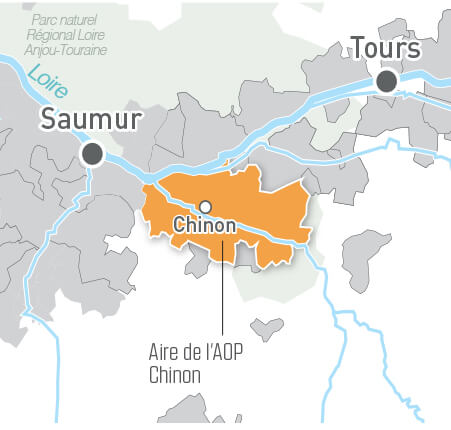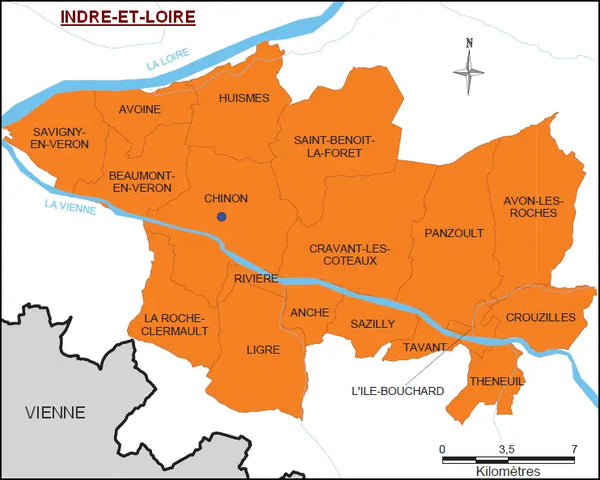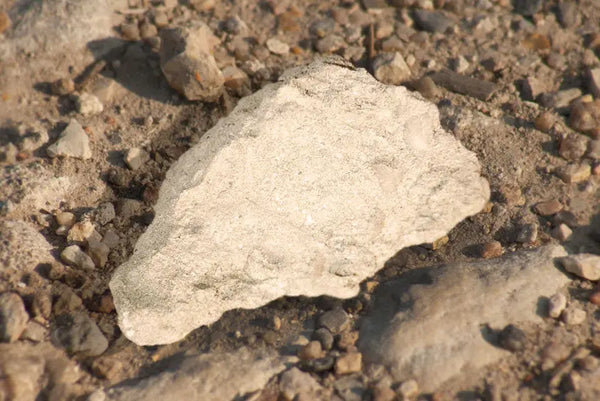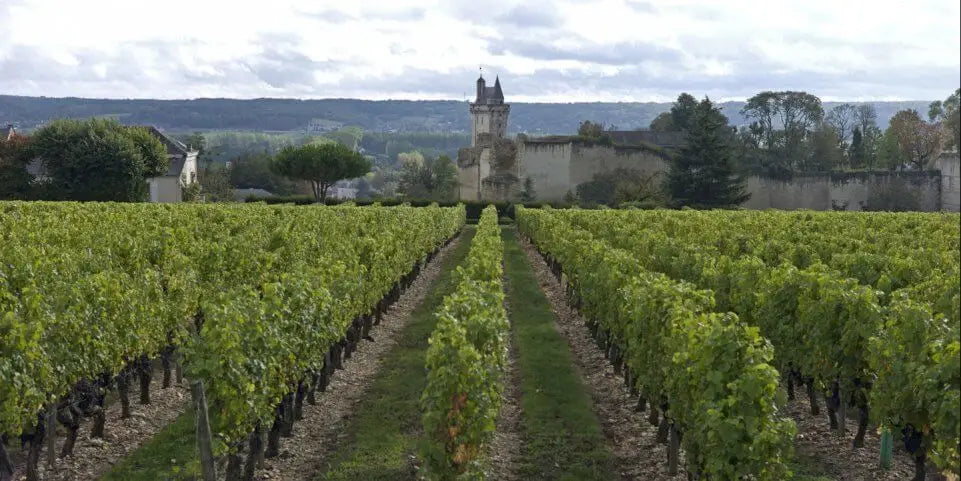Nestled between Saumur and Tours in the Loire Valley, Chinon is a wine appellation that perfectly embodies the elegance and diversity of the wines from its magnificent region.
Mainly known for its red wines made from the Cabernet Franc grape variety, Chinon is actually much more diverse than it appears, whether in terms of grape varieties, terroirs, or winemaking styles.
To better understand it, La Cave Éclairée offers you a complete immersion into this iconic Loire appellation. By the end of this reading, you will know everything about Chinon !

The Chinon AOC, between Saumur and Tours, crossed by the Vienne
History of the Chinon AOC
The wine history of Chinon dates back to the Gallo-Roman era. It is indeed believed that the vine was already present in these lands as early as the 2nd century AD. During this period, production was nevertheless only to meet local needs.
In the 12th and 13th centuries, viticulture allowed the town of Chinon to develop significantly. The local wines were then served at the courts of Henry II Plantagenet (King of England) and Philip II Augustus (King of France), making Chinon a royal wine.
In the 16th century, the region's wines entered the pantheon of literature thanks to François Rabelais and his famous Gargantua. “ — O Lacryma Christi ! — That’s wine from La Devinière, that’s pineau ! — Ah, the lovely white wine ! Upon my soul, it’s taffeta !”. This famous scene refers here to "La Devinière", a hamlet in the village of Seuilly, located a short distance from Chinon. The "pineau" mentioned here is in fact our current Chenin. Because yes, unlike today, white wine was once largely predominant in the Chinon vineyard!
In the 18th century, local wines were exported with great success thanks to Dutch merchants. They introduced Chinon wine to a wealthy foreign clientele, notably English and Dutch.
Finally, in 1937, the Chinon AOC was finally created and made it possible to protect the authenticity as well as the quality of the wines produced in the region.
Today, the appellation covers about 2,400 hectares spread over 26 villages and has more than 200 producers. The wines are consumed mainly in France, while 10% of the production is intended for export.

The villages of the Chinon AOC
Climate and soils of Chinon
The climate of Chinon is temperate oceanic, with continental influences. Winters are mild and summers moderately warm, allowing for slow and steady ripening of the grapes. Chinon actually enjoys the mildest climate in Touraine!
Rainfall is rather moderate and well distributed throughout the year, thus avoiding excessive water stress. Finally, depending on the vintage, the vineyard experiences the influence of cool and dry eastern winds as well as warmer and more humid western winds.
The diversity of terroirs is also one of the major assets of the appellation. The vineyard rests on a tuffeau subsoil (chalk) formed 90 million years ago. It is this same tuffeau that, for many centuries, was used to build houses and cellars.
On this chalk base, we then identify three main types of soils:
- Clay-limestone soils : located on the hillsides, these soils are conducive to the production of high-quality red wines, offering fine tannins and beautiful minerality.
- Sandy and gravelly soils : located in the valleys and plains along the Vienne, these soils generally produce lighter and fruitier wines, to be enjoyed young.
- Tuffeau soils : characteristic of the Chinon region, these chalky soils are perfect for white wines, bringing freshness and minerality.
However, be careful not to draw overly simplistic conclusions establishing a definitive causal link between soil types and wines... you can sometimes be very surprised during tastings!

The wines of the Chinon AOC
Accounting for 90% of local production, red wines are the flagship of the appellation. With more than 13 million bottles, Chinon is also the leading red wine appellation of the Loire !
Made from the Cabernet Franc grape variety, locally called "Breton", the reds here display aromas of fresh red and black fruits (blackcurrant, blackberry, strawberry, raspberry, etc.), combined with a certain minerality and subtle vegetal and spicy notes (notably pepper). Depending on the terroir and winemaking style, the tannins can be more or less pronounced and the body more or less dense. Some reds are enjoyed young, while others can be cellared for 10 years or more!
It should be noted that Cabernet Sauvignon can also be used as an accessory variety, up to a maximum of 10%. However, in practice, few winemakers use it.
These same grape varieties also allow the production of rosé wines, accounting for 8% of local production. These offer notes of fleshy red fruits such as cherry, strawberry, or raspberry and present a lovely texture on the palate.
Finally, white wines, which represented the majority of production a few centuries ago, are now very much in the minority (though delicious), accounting for only 2% of production. They are dry, made exclusively from Chenin grape variety and offer the taster liveliness, minerality, fruity notes (citrus, quince, peach, pear, apricot), and floral notes. Most are meant to be enjoyed within the first five years after their vintage.

Cabernet Franc vines on the Chinon AOC
What to eat with a Chinon ?
Such a palette of colors and wines obviously allows for many culinary pairings with the crus of the appellation! Here are some examples to ideally pair your cuvées.
- Charcuterie: the red wines of Chinon pair wonderfully with charcuterie. Saucisson, cured ham, and pork rillettes are a perfect match with the fresh and light reds of the appellation.
- White meats: a roast chicken, poultry in sauce, or a vegetable risotto are enhanced by the floral and fruity aromas of Chinon Chenins. However, full-bodied rosés and light reds can also work well depending on your preferences!
- Red meats: a rack of lamb, a beef fillet, or duck breast pair perfectly with the most structured red wines of the appellation. Here, do not hesitate to choose the most powerful and tannic cuvées.
- Cheeses: the region's goat cheeses, such as Sainte-Maure-de-Touraine, find an ideal companion in Chinon whites, their creamy texture balanced by a welcome liveliness.
- Fish and seafood: the dry white wines of Chinon pair perfectly with oysters, grilled fish, or shellfish, thanks to their freshness and minerality.
As you can see, a great many dishes can ideally be paired with at least one of the local colors!
What are the best Chinon wines ?
Among the emblematic producers of the Chinon appellation, the Domaine Fabrice Gasnier certainly stands out. Based in Cravant-les-Côteaux, the vineyard is cultivated using biodynamics and covers 35 hectares spread over the different soil types of the appellation. The family's wines are renowned for their purity and depth of fruit, making them a very safe bet. We therefore recommend their range which is flawless!
From easy-drinking wines to serious and complex cuvées, you are sure to find what you are looking for with them! And if you need advice, do not hesitate to contact La Cave Éclairée...
See you soon for more discoveries!

The entire Gasnier family








